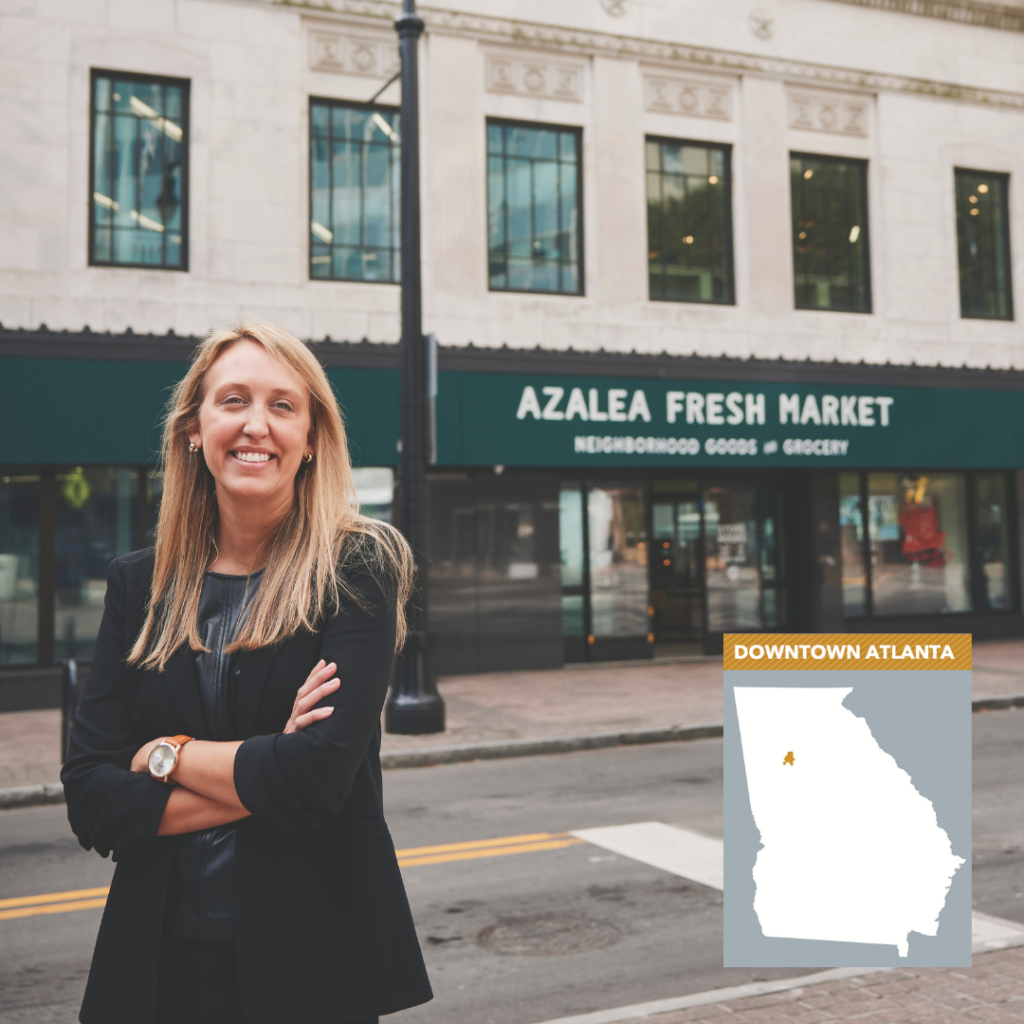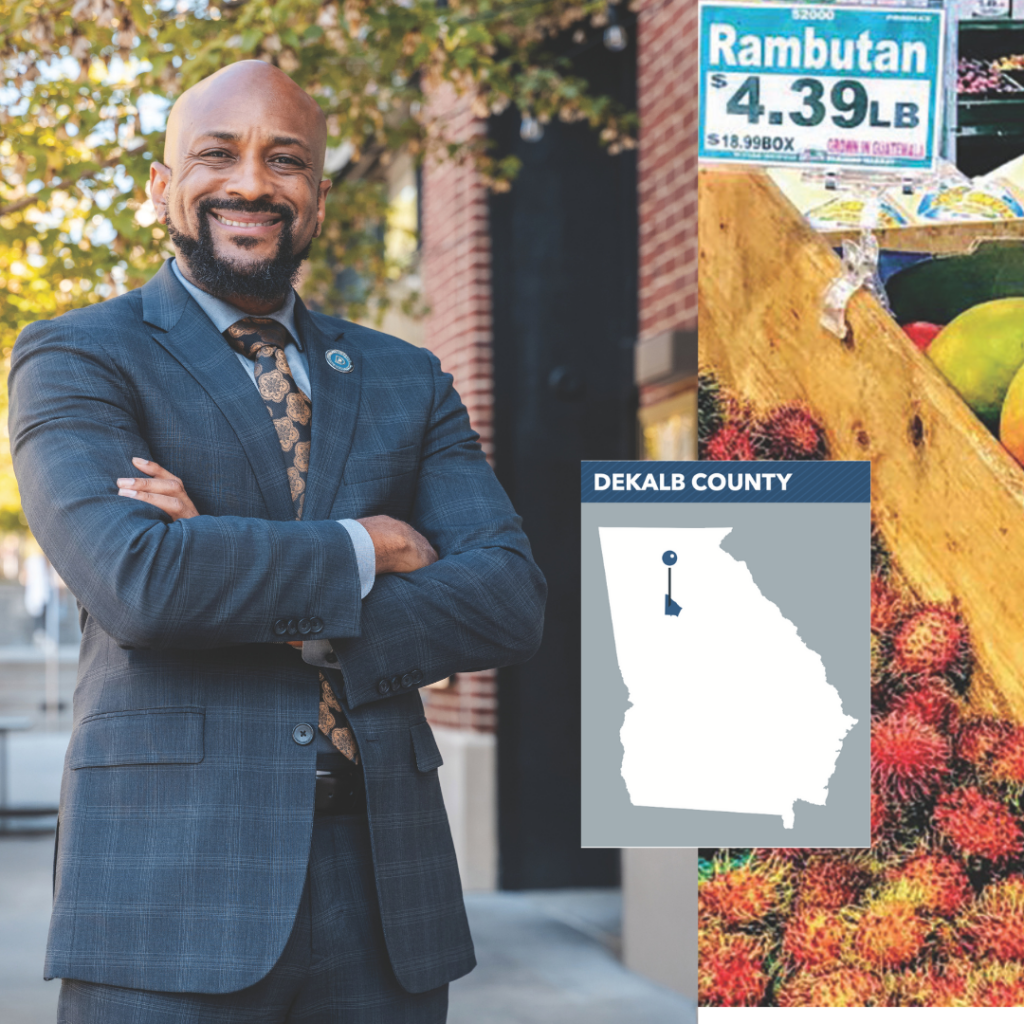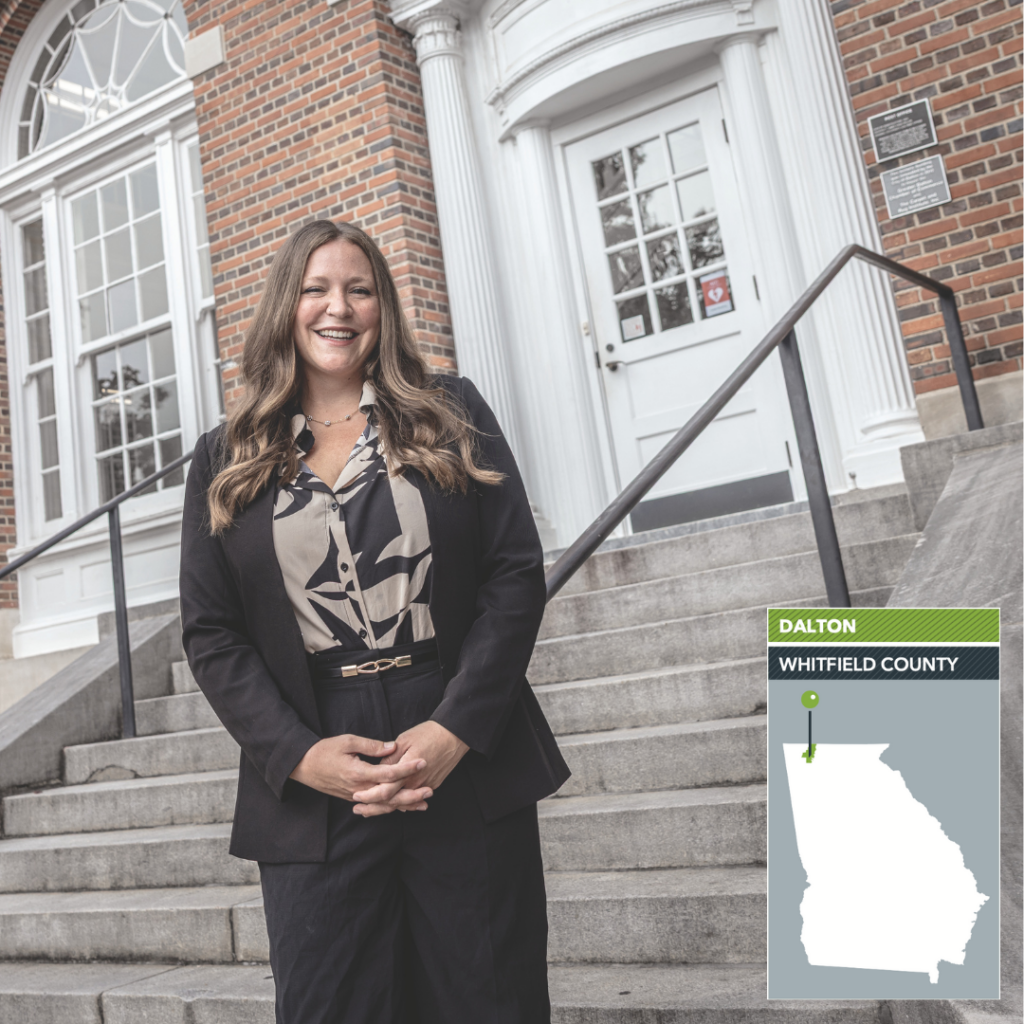Statesboro | Bulloch County: Success Breeds Success
Bulloch County has room to grow – in agriculture, education and manufacturing.
 If you are looking for a sign of the times for Bulloch County, you need look no further than the business card of Benjy Thompson, CEO of the Development Authority of Bulloch County. One side looks like a typical American business card. The other side is in Korean.
If you are looking for a sign of the times for Bulloch County, you need look no further than the business card of Benjy Thompson, CEO of the Development Authority of Bulloch County. One side looks like a typical American business card. The other side is in Korean.

Ideal Situation: Benjy Thompson, CEO of the Development Authority of Bulloch County, at the future site of the Hyundai metaplant; photo Frank Fortune.
The development of the Hyundai Motor Group Metaplant just over the county line in Bryan County is having a profound effect in the region, and aside from Bryan County itself, Bulloch is seeing the most impact. Three Tier-one suppliers to the plant are starting construction in facilities in southeast Bulloch near I-16, pacing to match or beat the Hyundai completion date of early 2025. A fourth automotive parts manufacturer, not directly related to Hyundai, has broken ground in Bulloch while a fifth major foreign-owned industrial company with no automotive connections at all is also building a plant there.
This newfound industrial might is forming a third prong of economic development for Bulloch County, joining agriculture (which has always been the county’s backbone) and the now fast-growing Georgia Southern University in Statesboro. The result is a diverse mix that economic developers seek as the ideal situation. And meanwhile, Statesboro is transitioning, poised on that hard-to-define border between large town and small city.
“This was a little bitty town that happened to have a university in it,” muses Thompson, looking out over the construction sites where massive equipment is stirring up dust.
Now, he counts off the incoming employers who are building facilities:
- Joon Georgia, part of auto parts manufacturer Ajin USA, is expected to bring 630 jobs and a $317 million investment. The Korean-owned company will produce automotive body parts for cars for the Hyundai plant.
- Ecoplastic, a Korean-based company, will generate an anticipated 456 jobs with a $205 million investment, producing plastic car parts such as bumpers for Hyundai.
- Hanon Systems will supply vehicle air conditioning systems for Hyundai and also for other manufacturers. Its $40 million investment is expected to generate 160 jobs.
To that set, add Aspen Aerogels, which makes insulation blankets for battery compartments of electric vehicles. It will hire an anticipated 250 employees with $325 million in investment. This project was announced ahead of the May 2022 Hyundai plant announcement and although ground has been broken, the construction is on hold for the moment, Thompson says. General Motors is a major customer of this firm, and the pause in construction came before the early fall UAW strikes against major automakers.

Profound Effect: Construction of the Hyundai Motor Group Metaplant is bringing business to nearby Bulloch County; photo Frank Fortune.
German-based plastics recycler revalyu Resources (US) is in the process of building its first U.S. facility. The plant, which will recycle PET plastic bottles, will account for 121 jobs on a $210 million investment.
Don’t let all the attention to new industries cause you to overlook Bulloch County’s homegrown base of existing industries, which currently employ about 2,500 people, Thompson says. The county has a great track record on retention, with no major industrial shutdowns in the past 20 years. The last big new industry to open prior to the current boom was Great Dane, maker of truck-tractors, in 2012. In addition to Great Dane, existing companies include Briggs & Stratton, which makes lawn equipment; Cardinal Glass, makers of residential window glass; GAF, which makes roofing products; Braswell Foods, which makes branded and private-label jellies, dressings and sauces; and a Walmart distribution center.
Education and Training

Family Business: The Sack Company in Statesboro is one of the largest mechanical, electrical, plumbing, millwright, rigging and equipment relocation/ installation companies in the Southeast; photo Frank Fortune.
Traditional industries don’t account for all of the construction boom in Bulloch County, however. Ogeechee Technical College (OTC), part of the Technical College System of Georgia, is also contributing, as it expands its education of industrial employees. Already, the college is training Amazon workers on things like industrial maintenance, with students traveling from across the country to receive the specialized training. Look for their numbers to grow, thanks to a new facility already taking shape – the 37,000-square-foot Georgia Industrial Systems and Industrial Robotics Training Center, which will be operated by OTC. The $19.7 million facility is slated for completion in March 2025, according to OTC President Lori Durden.
“We serve a lot of local industries, but Amazon sends us people from all over the country,” Durden says. “We are already doing this training now, but what this new facility will do is triple our capacity.” The college reports that it provided more than 102,000 hours in industrial systems and industrial robotics training in FY 2022, serving regional and national clients.
The two-story training center is being built on land donated by the Development Authority of Bulloch County. It will include labs for industrial systems, industrial robotics and programmable logic controller, or PLC, training.
Crops Remain Important
Agriculture has long been the dominant industry in Bulloch County. According to the Georgia Farm Gate Value Report for 2021, the farm gate value – that is, the price of farm produce purchased directly from the producer without markup – in Bulloch County was $188,173,833 in 2021.
This highly specific, crop-by-crop and county-by-county accounting shows Bulloch County ranked 18th among the state’s 159 counties in farm gate values. Cotton is the county’s leading crop, with the yield from its 44,122 acres placing it fifth in rank among Georgia counties. And the county’s harvest of 25,407 acres in peanuts makes Bulloch the 10th biggest peanut producer in the state.
But despite all that acreage, that $188,173,833 and a crop profile that ranges from soybeans to pecans, Christmas trees to tomatoes, the encroaching industrialization will have an impact because of its land use. Is Bulloch’s rural identity at stake? Roy Thompson, chair of the Bulloch County Board of Commissioners, doesn’t think so.
“We’re grateful because out of those who are in the process of locating and building here, it’s approximately 1,700 jobs, so there should be no excuse for anyone being unemployed,” Thompson says. “Bulloch County is one of the largest counties in Georgia. It’s large enough, if we manage our growth and land-use decisions like we should, there should be plenty of room for agriculture.”
He points out that the new industries are concentrated in the southeastern portion of the county, closest to the Hyundai plant in Bryan County.

Rural Identity: Roy Thompson, chair of the Bulloch County Board of Commissioners; photo Frank Fortune.
Still, factories are in the process of covering ground that once grew crops.
“We are losing farmland, and that is going to impact agriculture in Bulloch County,” says Bill Tyson, University of Georgia Cooperative Extension coordinator for Bulloch County. “This current year, there’s about 41,000 acres of cotton planted, and 26,000 acres to peanuts. We’re probably 100,000 acres of what is considered farmland.”
“Bulloch has always been a strong agricultural county and that’s not changed,” he says.
A Focus on Research
Statesboro grows another bumper crop, too – students. Georgia Southern University is a case study in how collegiate football, added in the ’80s, and the lottery-funded HOPE Scholarships, introduced in the ’90s, can take a small campus and make it an economic engine and population driver.
Kyle Marrero, president of Georgia Southern since 2019, has ambitions for the institution he leads: He envisions it as a research university.
“We’re on a trajectory in five areas of research, and in the next five to eight years we will be an R1 university,” Marrero says, referring to the research university classification set by the Carnegie Classification of Institutions of Higher Education. Current R1 institutions in Georgia include Emory University, Georgia State University, Georgia Tech and the University of Georgia.
Marrero says Georgia Southern’s research areas focus on direct impact in the Southeast Georgia and coastal area and include logistics and supply chain, advanced manufacturing, coastal resilience and sustainability, holistic wellness and fitness, and community vibrancy as reflected in public health and safety, such as the effort to extend rural healthcare.
As an example, he points to a project from the university’s doctorate in physical therapy (DPT) program that involved partnering with nearby Fort Stewart, where, by nature of their training, soldiers experience musculoskeletal injuries.
“We took 81 soldiers over a period of time to intertwine physical therapy and athletic training,” Marrero says. The results were promising enough to lead to a $5.6 million federal grant to scale the program up for other regional military bases in a “train the trainer” model, he says.

Promising Results: Jacob Gross, who is working to get a doctorate in physical therapy, works with ROTC Cadet and fellow GSU student Jamie Reed Kay on a shoulder-strengthening exercise; photo Georgia Southern University.
Georgia Southern welcomed a freshman class this fall of about 4,700, Marrero says. The University System of Georgia (as of this writing) had not yet released Fall 2023 enrollment figures, but Marrero predicts overall enrollment at Georgia Southern will be up about 2% – encouraging news after last fall’s drop of 5.9%.
Enrollment is a volatile subject for universities. Funding is linked to enrollment, but declining birth rates mean the supply of 18-year-olds to stock freshman classes is going down. Among the various strategies universities are employing in response, perhaps the most significant is an increased emphasis on graduate programs.
Marrero says Georgia Southern is adding two new doctoral programs in high-demand areas of applied computing and engineering. The university is also expanding the delivery of six graduate degree programs over the coming year to the Education Center at Fort Stewart and Hunter Army Airfield: an executive MBA, a Master of Public Administration, a Master of Science in IT, a master’s degree in professional communication and leadership and two graduate certificates in cybersecurity and professional communication.
Plans to Expand

Meeting City Needs: Statesboro Mayor Jonathan M. McCollar in one of the new Statesboro Area Transit System buses; photo Frank Fortune.
Meanwhile, a public works project designed to strengthen the university’s ties with the city has moved along significantly. The Blue Mile is envisioned as a pedestrian- and vehicle-friendly corridor leading from the front gate of Georgia Southern to downtown Statesboro, channeling, for instance, Saturday afternoon football crowds to restaurants and shops.
“We are several years away from completion, but we have the first third of it done. The vision is to bring it all the way up to the courthouse and eventually there’s going to be a roundabout in that area,” says Statesboro Mayor Jonathan M. McCollar.
What’s in place so far is impressive – widened sidewalks with brick-accented curb cuts, signage and (a significant part of the budget) moving utility lines further away from the route.
Still awaiting action is the dream of the Creek on the Blue Mile, a public-private partnership that envisions a waterway and linear park lined with bars and restaurants. So far, it exists on paper and in the form of a concreted-lined drainage ditch.
Statesboro took a step this spring in the evolution from town to city when it launched its first regular public transportation. The Statesboro Area Transit System is based inside the city limits with four small buses covering two routes. The Coastal Regional Commission is managing the system for the city, and it is funded by a combination of federal dollars channeled through the Georgia Department of Transportation and T-SPLOST funds, the mayor says.
“The goal is to allow it to expand based on need. We’re already getting commentary from citizens saying we need the buses to go in this area or that area,” McCollar says.
He is particularly proud of Statesboro’s recent work on housing in its older neighborhoods. The city has extended municipally owned water, sewer and gas service to recently annexed areas and has repaired dilapidated homes, replacing three that were too deteriorated to save.
Just as Statesboro is taking steps to adapt to growth and change, so is Bulloch County, which is why many expect agriculture, education and industry to continue to flourish there.
Local Flavor
Bulloch’s Pro Soccer Team
BULLOCH COUNTY IS TAKING ON a bit of international flair, and it’s not just from incoming European and Asian manufacturers or the growing university based there. Athletes are playing the world’s version of football – soccer – on a professional level in a newly constructed soccer stadium that used to be a cotton field.
The team is Tormenta FC – “tormenta” is Spanish for storm and the “FC” is for football club.
“In our crest, the animal that’s in there is an ibis, and the ibis is known for its bravery in a storm – the last to leave when a storm approaches and the first one back.
I just say if you have the audacity to play professional soccer in football-crazy South Georgia, you’d better be brave,” says Darin Van Tassell, who co-owns the team with his wife, Netra.
Pro soccer has a hierarchy, and atop the heap in Georgia is Atlanta United, part of Major League Soccer Division 1. Tormenta FC is a couple tiers down, a professional team paying a living wage and whose players have prospects of moving up. Tormenta FC 1 is part of the 12-team USL League One, (Division 3), and plays matches as far away as Fresno. Tormenta also has pre-professional men’s and women’s teams.
“We are the defending national champions in both the men’s and women’s teams,” says Van Tassell. “…There are only 12 teams that are professional for women, while there’s over 150 for men. That’s slowly changing. Our women are pre-professional and many of them still play in the NCAA.”
Many of the men’s team players are Americans, including three younger players this year who came up through Van Tassell’s soccer academy. The coach is Scottish and players on this year’s 23-man roster include representatives from Australia, England, Brazil and Ghana, for example.
Soccer, meanwhile, is having a moment in Georgia. Atlanta is one of 16 North American cities that will host a share of the 2026 FIFA World Cup, and the U.S. Soccer Federation announced in September that it will build its national training center in Atlanta.
“I was a sports person first, but if you are going to get into professional sports as an owner, you have to get into real estate,” says Van Tassell, who has parlayed his soccer team into a series of real-estate projects.
The stadium is part of a megaplex that he’s building in phases, and shaping residential, entertainment and hospitality around it – selling some parcels outright and leasing out others. That includes a family entertainment complex with go-carts and mini golf. “It has been the slow, slow growth of a small business that has led to this,” he adds.
But Van Tassell figures the numbers are on his side. The viewership of the Super Bowl is measured in millions; the World Cup records viewers in the billions.










